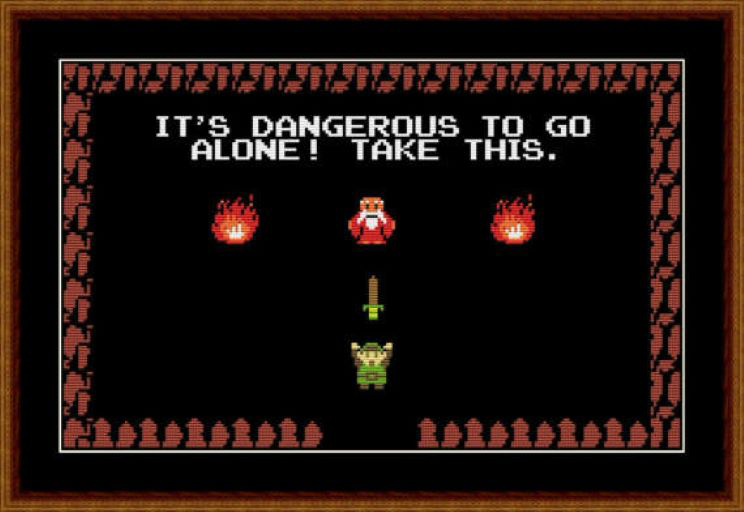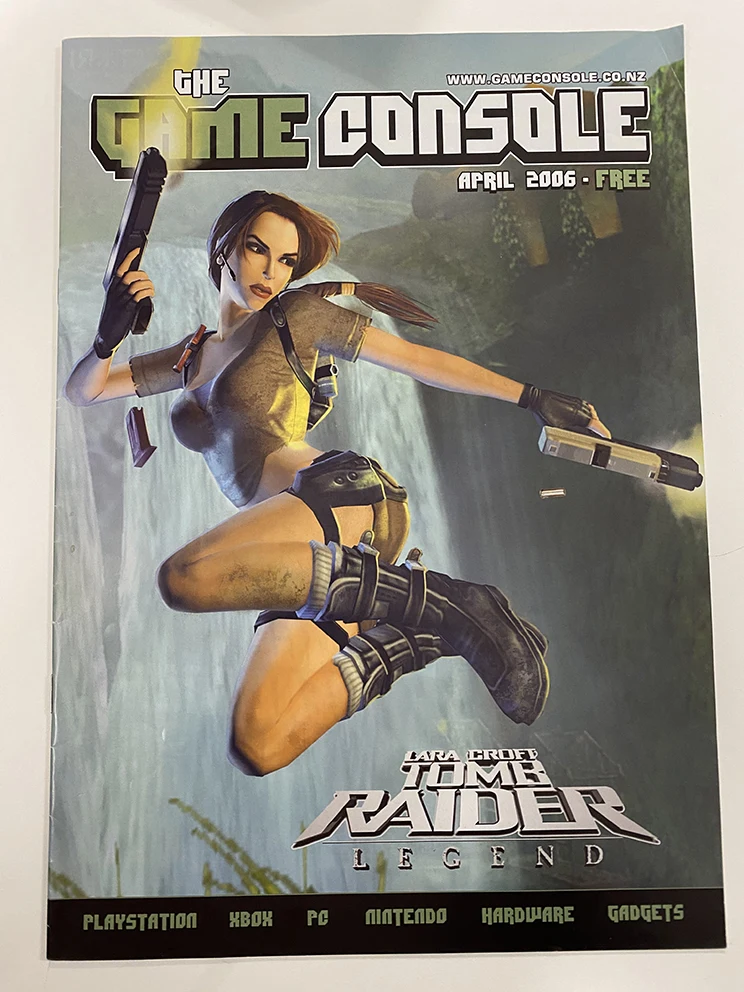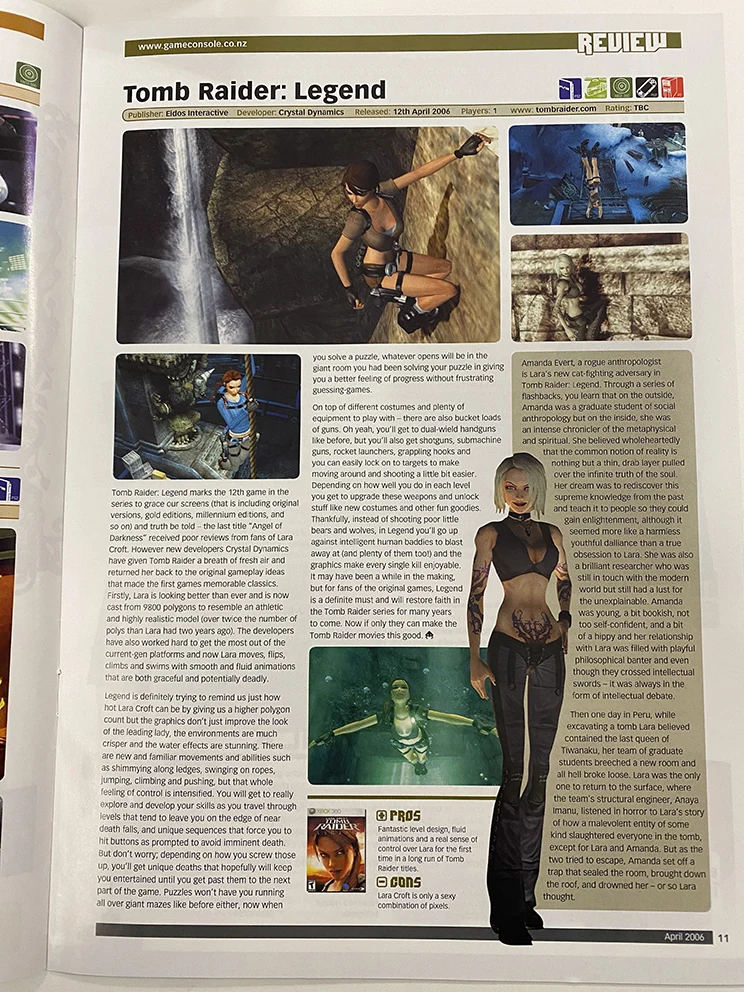‘It’s Dangerous To Go Alone! Take This.’ — Storytelling in video games and their preservation challenges
Finley Mudgway, Library Assistant, shares his love of video games and explores the challenges of preserving them in GLAM collections.
Video games tell powerful stories
Some of the most powerful stories I’ve ever experienced have been within the medium of video games. Even though this creative industry is one of the most financially successful in the world, and has turned out some of the most beloved media products of all time, there are still many who don’t equate video games with storytelling.

Embroidery of 1986 video game The Legend of Zelda. Screenshot from imflip website. License to use.
‘Would you kindly…’ — Video games and storytelling
For instance, let me ask you; What are the first things that come to mind when I mention the video game series Grand Theft Auto? Like most people, your thoughts probably instantly gravitate towards violence, drugs, sex, all the things which make that big red R18 sticker a necessary addition to the front cover. And you wouldn’t be at all incorrect to think that the Grand Theft Auto series has these contents.
However, I think it’s a real problem when these are the only things people think of. The most recent entry in the series, Grand Theft Auto Five, has one of the most impressive screenplays of the last ten years from across all different types of media. It’s a wonderful and hilarious social commentary, satire and parody of contemporary United States, blending an intensely engaging screenplay with interactivity to create an astounding achievement in storytelling.
Video game narratives are given a unique and fascinating spin by the interactivity of this medium. The player actively participates in the story being told, allowing for interactive storytelling tools to be used to effectively engage the player. See this Lessons From the Screenplay video for more on this topic.
This interactivity has allowed for some of the best stories of the last fifteen years, and it’s these stories and their themes which have had such a huge impact on me, teaching me much and even altering my perspective on certain things, the mark of a truly great narrative.
There are so many examples I could give of great video game stories; The Last of Us, God of War, Red Dead Redemption II, Assassin’s Creed 2, and Uncharted 4, all of which contain serious thematic material on several potentially intimidating topics. Uncharted 4 alone discusses the ruinous nature of obsession, the beauty of a ‘normal’ life, and the precarious relationship between self-esteem and identity.
Some video game narratives also delve into political and ideological discussions. Influenced by the famous literary work Atlas Shrugged by Russian-born writer and philosopher Ayn Rand, The ‘Bioshock’ series lays out and dissects philosophies such as Objectivism and American Exceptionalism in beautiful and haunting story worlds that encompass these philosophies. I’d highly recommend watching this video on The Philosophy of the Bioshock series.
‘I used to be an adventurer like you….’ – Video game ephemera in the collections
Given my love for this storytelling medium, I couldn’t help but wonder what video game-related items the National Library and Alexander Turnbull Library collections held, or if there were any actual video games in the collection.
In my search to find this out, I was surprised and delighted to find a few unique ephemera items; EB Games promotional booklets from the early to mid-2000s. It was fascinating looking through these booklets, seeing the “New Release” sections with the Nintendo Console I received for Christmas when I was young, and all the games I played throughout my childhood years.
Photo from Electronics Boutique catalogue. Autumn 2002. Ref: Eph-B-COMPUTER-Games-1990/2009. Alexander Turnbull Library. Photo by Finley Mudgway.

Photo from Electronics Boutique catalogue. Autumn 2002. Ref: Eph-B-COMPUTER-Games-1990/2009. Alexander Turnbull Library. Photo by Finley Mudgway

One of the covers promoted the (at the time) newest Lara Croft game, Tomb Raider: Legend, a story that had a massive influence on me as a kid. I remember being completely captivated by the story of Lara trying to find out what happened to her mother, who vanished when she was a child, as well as being able to digitally explore the globe in places such as Bolivia, Ghana, Japan and Peru.
It would be easy at first glance for someone to see these ephemera items as disposable or as nothing more than 20-year-old junk mail. However, I was very relieved and excited to find that the Library is preserving these booklets alongside their other valuable ephemera items. For people like me who love video games, these small booklets are windows into the past, important pieces of history.

The Game Console, April 2006. Ref: Eph-B-COMPUTER-Games-1990/2009. Alexander Turnbull Library. Photo by Finley Mudgway
Given that the booklets are documentation of significant narrative achievements, they are just as relevant to us as Librarians as the other valuable documents and collections of narratives that we safeguard. They truly deserve the place of preservation that they have.
‘Thank you, Mario! But our Princess is in another castle!’ – The challenges of video game collection and preservation
Upon finding these booklets I wanted to expand my search. What other treasures lay hidden in the Library’s depths? Who had information on this topic and what secrets would they be able to tell me?
While looking into what further items I could find, and wondering if the Library held any actual video games (digitized or otherwise) I was able to learn of a very interesting challenge facing the Library; The difficulty of collecting and preserving video games. I was able to get in contact with many lovely people within the library who were able to explain the many sides of this challenge.
There are only a few video games in the Turnbull collections, as they have traditionally fallen outside the scope of ATL’s collecting priorities. However, various teams and groups in the library, such as Contemporary Voices and Archives and the Emerging Formats Working group, have discussed collecting video games and acknowledging their cultural significance, but it’s a massive digital preservation challenge.
Video games tend to pose significant long-term preservation and access challenges for a few reasons, copyright being a significant one. The copyright rules surrounding the sharing of video games are far more restrictive than other forms of media, which prevents and discourages libraries and archives from collecting and providing access to games.

The Game Console, April 2006. Ref: Eph-B-COMPUTER-Games-1990/2009. Alexander Turnbull Library. Photo by Finley Mudgway
As well as this, the equipment, applications and operating systems used to run them become obsolete so quickly with the rapid advancement of technology. However, it’s not only the obsolescence of technology that presents a challenge but also the preservation of the interactive experience.
Each video game has a specific experience of input and response that is difficult to preserve or recreate on subsequent generations of hardware and software but is the most important aspect of the gaming experience. When a game plays differently than originally intended, it loses some of its essential character.
Due to these challenges and ongoing discussions, video games are not currently part of the collecting priorities of the Library. However, comics, zines and publications about gaming are collected, publications such as the booklets I came across. Many thanks to Ashwinee Pendharkar, Valerie Love, Blanche Joslin, Martin Gengenbach and Sam Orchard for giving their time and being kind enough to answer my questions.
‘Endure and survive’ — Conclusion
Obtaining video games for collections comes with many challenges and organisations across the GLAM sector are facing these issues. Video games and their narratives are a vital part of storytelling culture and the items we hold in the collections have great value, you just need to take the time to look at them. Hopefully, the Library will be able to obtain items from such an important corner of storytelling culture in the future.
More about video games
Story mode — a video series from the team behind Lessons from the Screenplay dedicated to exploring storytelling in video games.
The story of the moving image, videogames — Article from ACMI (Australian Centre for the Moving Image) about video game development
Awesome mahi Finley! So interesting and lots of things that I hadn't considered before regarding the preservation challenges. Love your work :-)